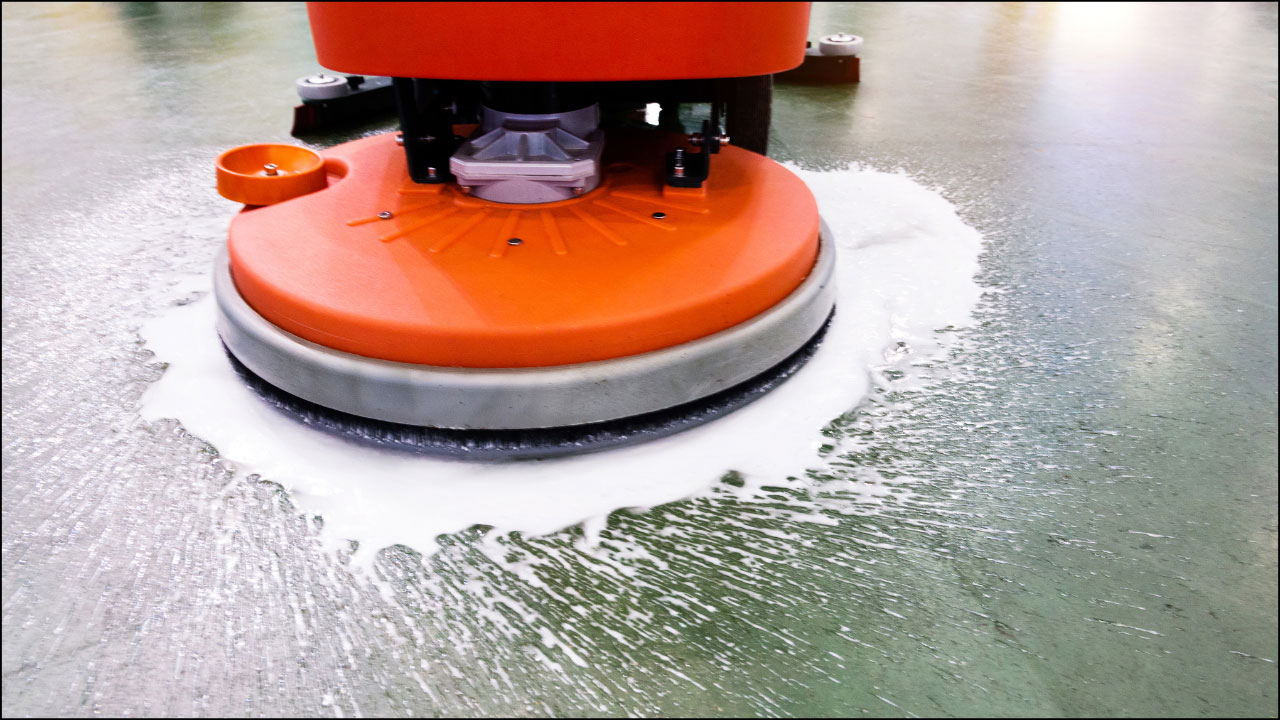Key Takeaways
- Floor stripping chemicals are essential for removing old floor finishes and preparing surfaces for a new finish.
- These chemicals come in various types, including solvent-based, water-based, and enzyme-based strippers.
- Using the right floor stripping chemicals ensures an effective, time-saving, and safe stripping process.
- Purchase from suppliers that offer fast shipping, exclusive offers, and product expert assistance.
- Professional floor strip and wax services can handle the stripping process efficiently and safely, saving you time and effort.
Floor stripping chemicals are specialized solutions used to remove old floor finishes from various floor surfaces. These chemicals are an essential component of floor strip and wax services, as they effectively break down the layers of finish, dirt, and grime, preparing the floor for a fresh new finish.
In this blog, we will explore what floor stripping chemicals are, their importance, and how they work in the floor stripping process.
Understanding Floor Stripping Chemicals
What is a floor stripping chemical? It is a powerful cleaning agent designed to dissolve and remove old floor finishes. These chemicals penetrate the layers of wax, finish, and embedded dirt, making it easier to scrub them away. Different types of floor strippers are formulated for various floor surfaces to ensure effectiveness without damaging the floor.
Types of Floor Stripping Chemicals
There are several types of floor stripping chemicals available, each suited for different needs and floor types. Here’s an in-depth look at the various options:
1. Solvent-Based Strippers
Solvent-based strippers are known for their strength and effectiveness in removing tough, old finishes. They work by dissolving the layers of wax and finish quickly, making them a popular choice for heavily coated floors. However, they come with some considerations:
- Effectiveness: These strippers are highly effective at breaking down multiple layers of old finish, dirt, and grime, making them ideal for floors with significant buildup.
- Handling: Due to their strong chemical composition, solvent-based strippers produce strong fumes that can be hazardous if inhaled. It’s important to use protective equipment, such as gloves, masks, and eye protection, when handling these chemicals.
- Ventilation: Adequate ventilation is crucial when using solvent-based strippers to prevent the buildup of toxic fumes. Ensure that the area is well-ventilated, or use exhaust fans to remove fumes from the workspace. Because of this, professional janitorial cleaning services are often recommended to observe property safety procedures.
2. Water-Based Strippers
Water-based strippers offer a safer and more environmentally friendly alternative to solvent-based options. They are designed to remove finishes without the harsh chemicals, making them suitable for less severe buildup. Key features include:
- Safety: Water-based strippers are generally safer to use, producing fewer fumes and posing less risk to health and the environment. They are a preferred choice for indoor spaces where ventilation might be limited.
- Ease of Use: These strippers are easier to handle and apply, often requiring less protective equipment compared to solvent-based strippers.
- Effectiveness: While not as potent as solvent-based strippers, water-based strippers are effective for regular maintenance and light to moderate buildup.
- Eco-Friendly: Many water-based strippers are biodegradable and contain fewer harmful chemicals, making them a more sustainable choice for environmentally conscious users.
3. Enzyme-Based Strippers
Enzyme-based strippers utilize natural enzymes to break down finishes. These products are known for their safety and effectiveness on a wide range of floor types, including sensitive surfaces. Their features include:
- Natural Ingredients: Enzyme-based strippers use natural enzymes to digest and break down the floor finish, making them safe for use on delicate and sensitive surfaces such as natural stone and certain types of vinyl.
- Safety: These strippers are non-toxic and produce minimal fumes, making them a safe choice for use in homes, schools, healthcare facilities, and other sensitive environments.
- Versatility: Enzyme-based strippers are suitable for most floor types, including those that may be damaged by harsh chemicals. They are especially effective for routine maintenance and mild to moderate finish buildup.
Choosing the Right Floor Stripping Chemical
Selecting the appropriate floor stripping chemical depends on several factors, including the type of floor, the level of buildup, and the environment in which the product will be used. Here are some tips to help you choose the right product:
- Assess the Floor Type: Identify the type of floor surface you need to strip. Solvent-based strippers are best for tough, resilient floors, while water-based and enzyme-based strippers are suitable for more sensitive surfaces.
- Determine the Level of Buildup: Evaluate the severity of the finish buildup. Heavily coated floors might require the strength of solvent-based products, whereas light to moderate buildup can be effectively handled with water-based or enzyme-based strippers.
- Consider Safety and Environment: For indoor spaces with limited ventilation or environments with stringent safety requirements, water-based and enzyme-based strippers are preferable due to their lower toxicity and minimal fumes.
How Floor Stripping Chemicals Work
Floor stripping chemicals work by breaking down the chemical bonds in the layers of floor finish. Here’s a step-by-step overview of how they are used:
- Preparation: Before applying the chemical, clear the area of furniture and place wet floor signs. Ensure you have all necessary supplies, including floor strippers, mops, scrub brushes, and protective equipment.
- Mixing the Solution: Follow the instructions to mix the floor stripper with water, usually in a ratio of 20 – 58 gallons per bucket, depending on the concentration required.
- Application: Apply the mixed solution generously across the floor surface. Let it sit for the recommended time to allow the chemical to penetrate and break down the old finish.
- Scrubbing: Use a floor machine with a scrubbing pad to agitate the solution and remove the dissolved finish. This step may need to be repeated for heavily coated areas.
- Removal: Use a wet vacuum to remove the stripping solution, along with the old finish and dirt. Rinse the floor thoroughly with clean water to remove any remaining residue.
Restore Your Floors with Professional Floor Cleaning Services
For expertly cleaned and rejuvenated floors, trust Janitorial Cleaning Los Angeles. Our comprehensive floor strip and wax services ensure your floors look their best with minimal hassle. Contact us today to schedule your professional floor cleaning service and experience the transformative results of our expert care.



